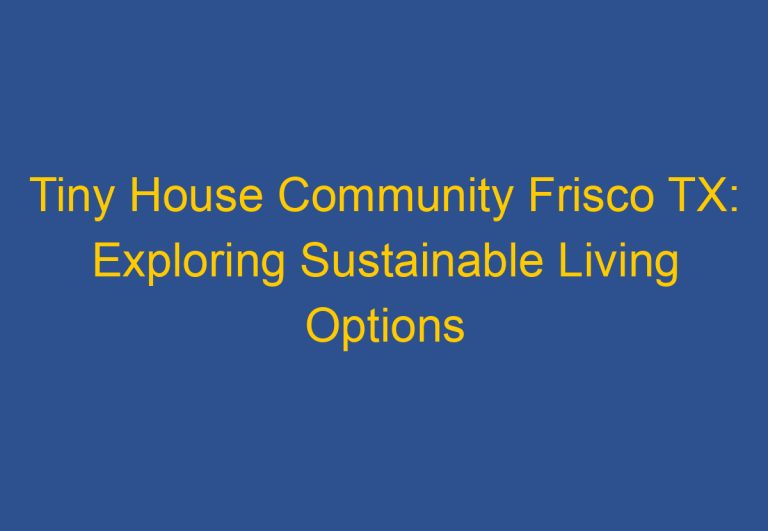Where Can I Put a Tiny House in Georgia: A Comprehensive Guide
Tiny houses have become increasingly popular in recent years, offering a minimalist and affordable lifestyle. However, finding a place to put a tiny house can be a challenge due to zoning laws and regulations that vary from place to place. In Georgia, there are specific regulations and guidelines that must be followed when it comes to building and placing a tiny house.
One option for placing a tiny house in Georgia is RV parks and campgrounds. These locations often allow tiny houses, but it’s important to research and ensure they are a suitable option. Additionally, some cities in Georgia have zoning regulations that permit tiny houses, including Atlanta, Savannah, and Athens. It’s important to check with local authorities to ensure compliance with all regulations and guidelines.
Another option is to join a tiny house community, such as Little River Escape in Menlo, Georgia. These communities are designed specifically for tiny house owners and offer a range of amenities and benefits, including a supportive community and access to shared resources. However, it’s important to note that these communities often have their own rules and regulations that must be followed.
Understanding Tiny House Regulations in Georgia
If you’re considering building or buying a tiny house in Georgia, it’s important to understand the state’s regulations and requirements. Georgia has few rules and regulations regarding tiny houses, but there are still some things you need to know before you start building.
Zoning Laws and Building Codes
In Georgia, tiny homes must be up to code with the International Residential Code (IRC). This means that your home must meet certain standards for safety and habitability. Additionally, your home must be insured and licensed as a dwelling unit. The Georgia Department of Community Affairs provides a fact sheet that outlines the different types of tiny homes and building codes that apply to them. It’s important to identify which types of tiny homes fall within the scope and application of building codes.
Moreover, local zoning regulations play a significant role in determining where you can put your tiny house. Some counties in Georgia allow tiny houses, while others have specific zoning laws that prohibit them. For example, in Banks County, you will require a construction permit to build a tiny house. The Banks County Zoning Department is responsible for issuing the permission. Therefore, it’s crucial to research local zoning ordinances and laws before you start building or parking your tiny house.
Minimum Size and Safety Requirements
Georgia does not have a minimum square footage requirement for tiny homes, but it’s essential to ensure that your home meets safety standards. Tiny homes must have adequate fire safety measures and sanitation facilities. The Georgia Department of Community Affairs provides guidelines for fire safety and sanitation in tiny homes. These guidelines include requirements for smoke detectors, carbon monoxide detectors, and fire extinguishers.
In conclusion, understanding Georgia’s regulations and requirements for tiny houses is crucial before building or buying one. Zoning laws, building codes, and safety requirements are essential considerations for anyone planning to live in a tiny house.
Finding Locations for Tiny Houses in Georgia
If you’re looking to put a tiny house in Georgia, there are a few options to consider. This section will provide an overview of some of the most common locations where tiny homes can be placed in Georgia.
Urban and Rural Options
Tiny homes can be placed in both urban and rural areas throughout Georgia. In urban areas, tiny homes are often placed on private property, such as a backyard or a vacant lot. However, it’s important to check local zoning laws and building codes to ensure that the tiny home is allowed in that particular area.
In rural areas, tiny homes can be placed on private land without many restrictions. However, it’s still important to check local zoning laws and building codes to ensure that the tiny home is up to code and meets all safety standards.
Tiny House Communities and Private Land
There are also several tiny house communities throughout Georgia that offer a unique and sustainable living experience. For example, Little River Escape is an exclusive 50-acre community designed specifically for tiny house owners, nestled in the scenic mountains of Menlo, Georgia. The community features a range of delightful amenities, such as a communal garden, fire pit, and hiking trails.
Private land is also an option for placing a tiny home in Georgia. However, it’s important to ensure that the land is zoned for residential use and that the tiny home meets all building codes and safety standards. It’s also important to have a good relationship with the landowner and obtain any necessary permits before placing a tiny home on their property.
Overall, there are many options for finding a location for a tiny home in Georgia. Whether you’re looking to live in an urban area or a rural setting, there are plenty of opportunities to enjoy the benefits of tiny home living in the Peach State.
Frequently Asked Questions
What are the zoning regulations for tiny houses in Georgia?
Zoning regulations for tiny houses vary by county in Georgia. Some counties allow tiny houses as long as they meet certain requirements, while others have specific zoning regulations for tiny houses. It is important to research the zoning regulations in your specific county before purchasing or building a tiny house.
Is there a minimum square footage requirement for homes in Georgia?
There is no state-wide minimum square footage requirement for homes in Georgia. However, some counties may have their own minimum square footage requirements. It is important to research the regulations in your specific county before building a tiny house.
Can I legally place a tiny house on my own land in Georgia?
Yes, it is legal to place a tiny house on your own land in Georgia. However, it is important to research the zoning regulations in your specific county before doing so. Some counties may have restrictions on the placement of tiny houses, even on private property.
How many tiny houses are allowed per acre in Georgia?
The number of tiny houses allowed per acre in Georgia varies by county and is dependent on zoning regulations. Some counties may have restrictions on the number of tiny houses allowed per acre, while others may not have any restrictions at all. It is important to research the regulations in your specific county before building a tiny house.
Which counties in Georgia are most accommodating to tiny houses?
Several counties in Georgia are accommodating to tiny houses, including Fulton, Dekalb, Barrow, Gwinnett, and Cherokee. Each county may have its own set of regulations and restrictions on the size, location, and use of the tiny house.
What is the process for obtaining a building permit for a tiny house in Georgia?
The process for obtaining a building permit for a tiny house in Georgia varies by county. It is important to research the regulations in your specific county before beginning the process. Generally, the process involves submitting plans and obtaining approval from the local zoning board or building department.










